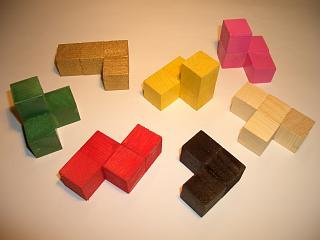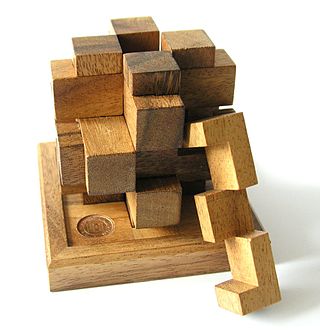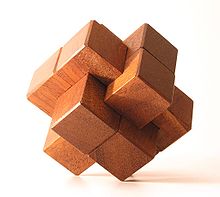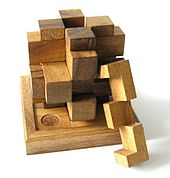
Samuel Loyd was an American chess player, chess composer, puzzle author, and recreational mathematician. Loyd was born in Philadelphia but raised in New York City.

The Soma cube is a solid dissection puzzle invented by Danish polymath Piet Hein in 1933 during a lecture on quantum mechanics conducted by Werner Heisenberg.

The tangram is a dissection puzzle consisting of seven flat polygons, called tans, which are put together to form shapes. The objective is to replicate a pattern generally found in a puzzle book using all seven pieces without overlap. Alternatively the tans can be used to create original minimalist designs that are either appreciated for their inherent aesthetic merits or as the basis for challenging others to replicate its outline. It is reputed to have been invented in China sometime around the late 18th century and then carried over to America and Europe by trading ships shortly after. It became very popular in Europe for a time, and then again during World War I. It is one of the most widely recognized dissection puzzles in the world and has been used for various purposes including amusement, art, and education.

A jigsaw puzzle is a tiling puzzle that requires the assembly of often irregularly shaped interlocking and mosaicked pieces. Typically each piece has a portion of a picture, which is completed by solving the puzzle.

A mechanical puzzle is a puzzle presented as a set of mechanically interlinked pieces in which the solution is to manipulate the whole object or parts of it. While puzzles of this type have been in use by humanity as early as the 3rd century BC, one of the most well-known mechanical puzzles of modern day is the Rubik's Cube, invented by the Hungarian architect Ernő Rubik in 1974. The puzzles are typically designed for a single player, where the goal is for the player to discover the principle of the object, rather than accidentally coming up with the right solution through trial and error. With this in mind, they are often used as an intelligence test or in problem solving training.

Disentanglement puzzles are a type or group of mechanical puzzle that involves disentangling one piece or set of pieces from another piece or set of pieces. Several subtypes are included under this category, the names of which are sometimes used synonymously for the group: wire puzzles; nail puzzles; ring-and-string puzzles; et al. Although the initial object is disentanglement, the reverse problem of reassembling the puzzle can be as hard as—or even harder than—disentanglement. There are several different kinds of disentanglement puzzles, though a single puzzle may incorporate several of these features.

Pick-up sticks, pick-a-stick, jackstraws, jack straws, spillikins, spellicans, or fiddlesticks is a game of physical and mental skill in which a bundle of sticks, between 8 and 20 centimeters long, is dropped as a loose bunch onto a table top into a random pile. Each player, in turn, tries to remove a stick from the pile without disturbing any of the others. The object of the game is to pick up the most sticks or to score the most points based on the color of the sticks.

Frame and panel construction, also called rail and stile, is a woodworking technique often used in the making of doors, wainscoting, and other decorative features for cabinets, furniture, and homes. The basic idea is to capture a 'floating' panel within a sturdy frame, as opposed to techniques used in making a slab solid wood cabinet door or drawer front, the door is constructed of several solid wood pieces running in a vertical or horizontal direction with exposed endgrains. Usually, the panel is not glued to the frame but is left to 'float' within it so that seasonal movement of the wood constituting the panel does not distort the frame.
A dissection puzzle, also called a transformation puzzle or Richter puzzle, is a tiling puzzle where a set of pieces can be assembled in different ways to produce two or more distinct geometric shapes. The creation of new dissection puzzles is also considered to be a type of dissection puzzle. Puzzles may include various restraints, such as hinged pieces, pieces that can fold, or pieces that can twist. Creators of new dissection puzzles emphasize using a minimum number of pieces, or creating novel situations, such as ensuring that every piece connects to another with a hinge.
Stick puzzles are a type of combination puzzle that uses multiple sticks or 'polysticks' to assemble two- or three-dimensional configurations.

In woodworking and carpentry, a pair of winding sticks is a tool that aids in viewing twist in pieces of lumber by amplifying the defect. Winding sticks can be as simple as any two straight sticks or they can be elegant, decorated, dimensionally stable wood like mahogany. A pair of framing squares may also be suitable. Traditionally they are 16 inches (41 cm) to 30 inches (76 cm) long, 1+3⁄4 inches (44 mm) tall and tapered in their height from 3⁄8 inch (9.5 mm) to 1⁄8 inch (3.2 mm). The longer the winding sticks, the more they will amplify the wind. It is common for a woodworker to make a matching pair for the purpose, and contrasting colors of woods improve the discernability of differences in level between the two sticks as they are compared.

Gess is an abstract strategy board game for two players, involving a grid board and mutating pieces. The name was chosen as a conflation of "chess" and "Go". It is pronounced with a hard "g" as in "Go", and is thus homophonous with "guess".

The T puzzle is a tiling puzzle consisting of four polygonal shapes which can be put together to form a capital T. The four pieces are usually one isosceles right triangle, two right trapezoids and an irregular shaped pentagon.

The diabolical cube is a three-dimensional dissection puzzle consisting of six polycubes that can be assembled together to form a single 3 × 3 × 3 cube. The six pieces are: one dicube, one tricube, one tetracube, one pentacube, one hexacube and one heptacube, that is, polycubes of 2, 3, 4, 5, 6 and 7 cubes.
The Crown of Thorns is a woodworking technique of tramp art using interlocking wooden pieces that are notched to intersect at right angles forming joints and self-supporting objects, objects that have a "prickly" and transparent quality. Common examples include wreath-shaped picture frames that look similar to Jesus' "crown of thorns".

A tally stick was an ancient memory aid used to record and document numbers, quantities, and messages. Tally sticks first appear as animal bones carved with notches during the Upper Palaeolithic; a notable example is the Ishango Bone. Historical reference is made by Pliny the Elder about the best wood to use for tallies, and by Marco Polo (1254–1324) who mentions the use of the tally in China. Tallies have been used for numerous purposes such as messaging and scheduling, and especially in financial and legal transactions, to the point of being currency.

The Altekruse Puzzle is a type of burr puzzle invented by Austrian inventor William Altekruse.
Stewart Coffin is an American puzzle maker. According to Ars Technica, he is considered to be one of the "best designers of polyhedral interlocking puzzles in the world."

Pentangle, later Pentangle Puzzles, was a British manufacturer and distributor of burr puzzles and other mechanical puzzles. It operated in the UK from 1971 until 2018. It was best known as the first company to distribute what became called "Rubik's Cube" outside Hungary.
The second season of The Challenge: All Stars premiered on Paramount+ on November 11, 2021. The season features twenty-four cast members from The Real World, Road Rules and The Challenge competing for $500,000.





























